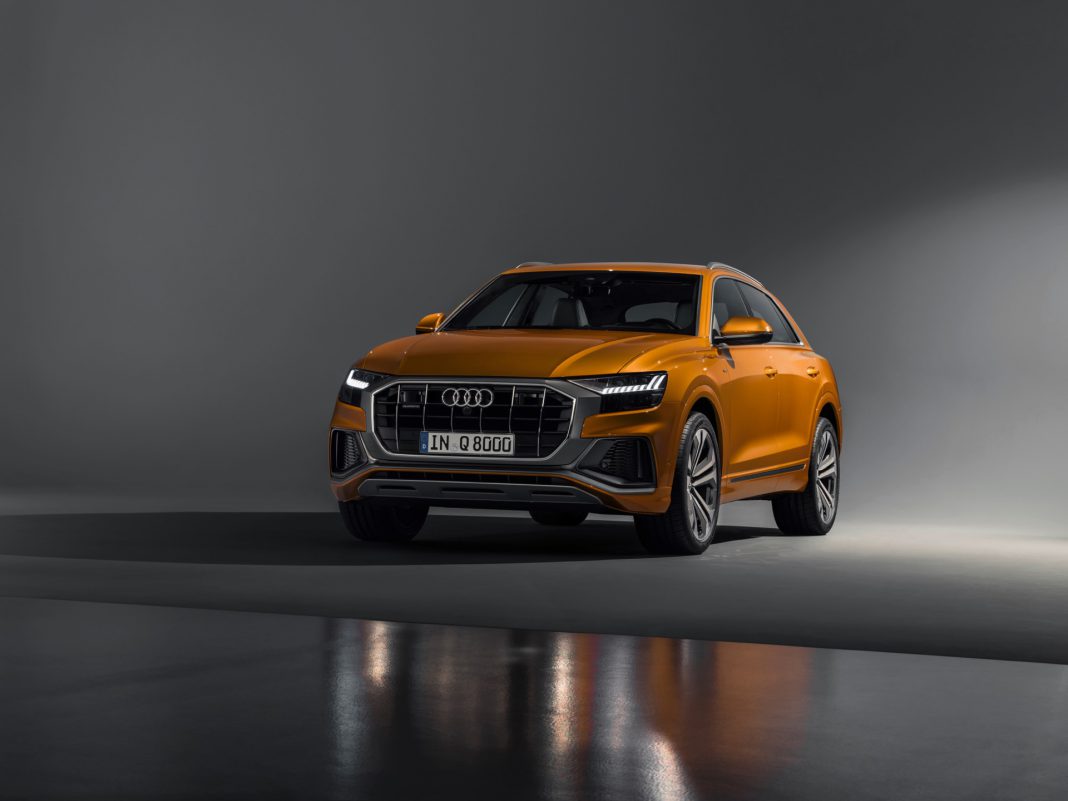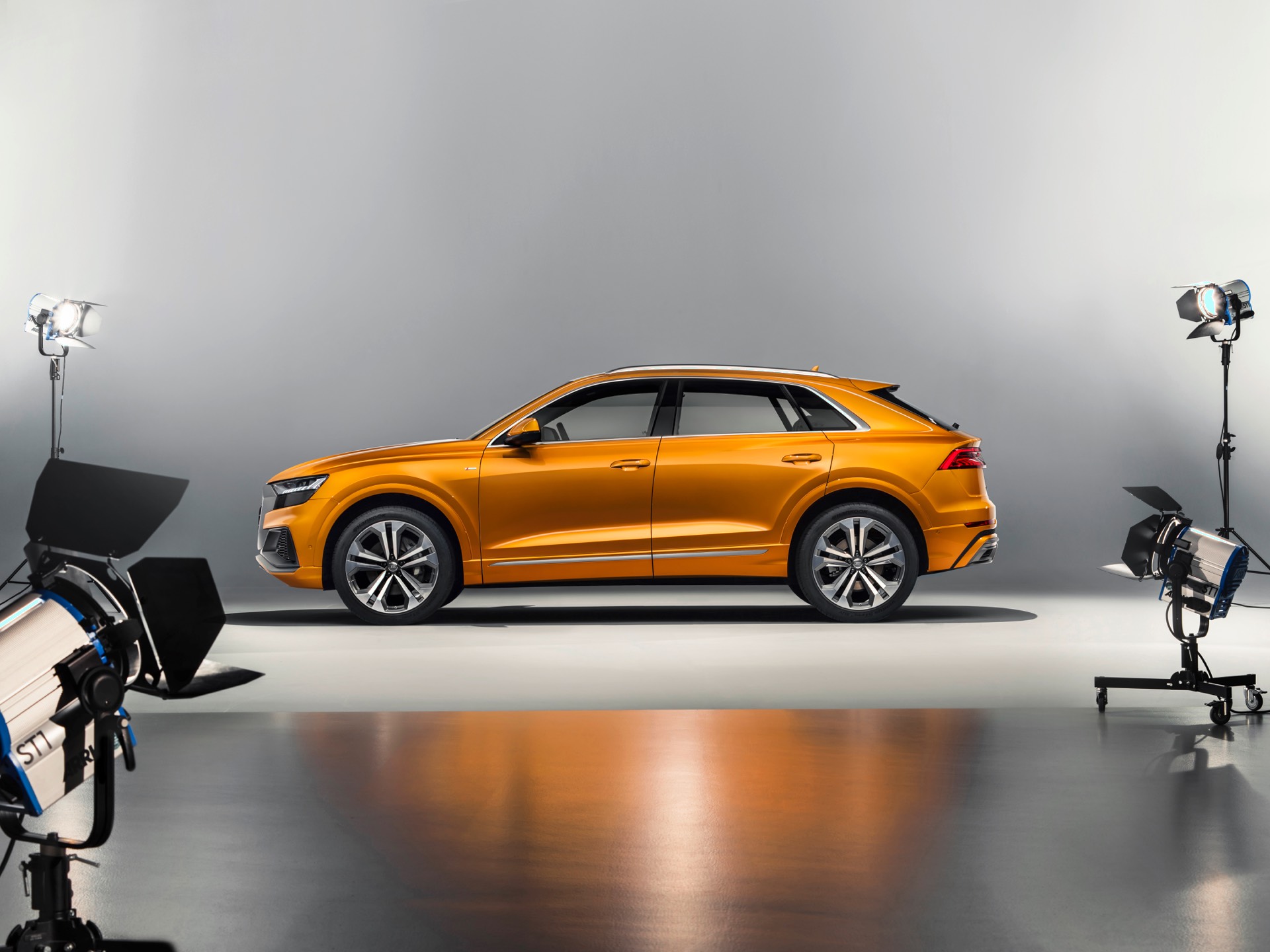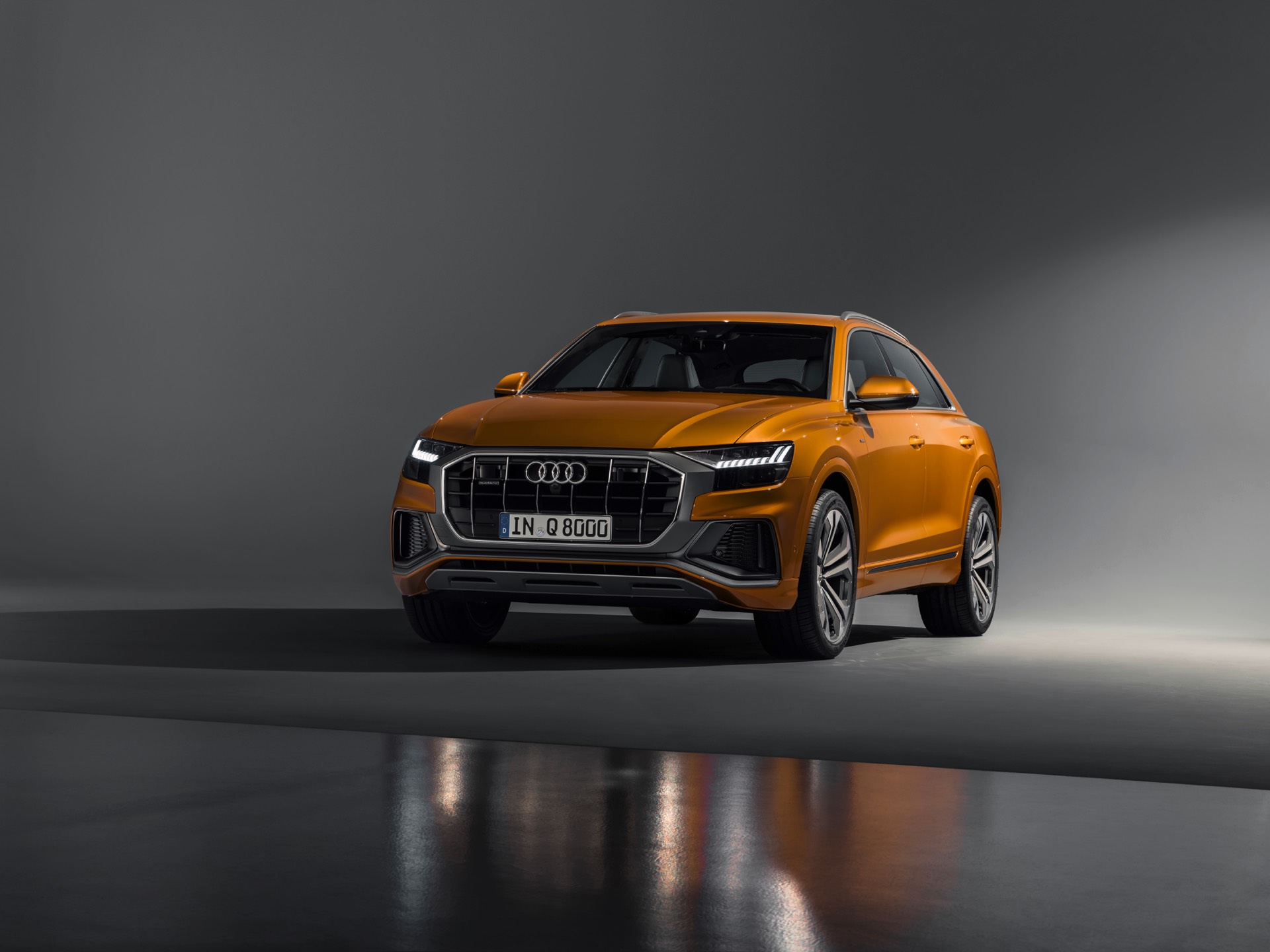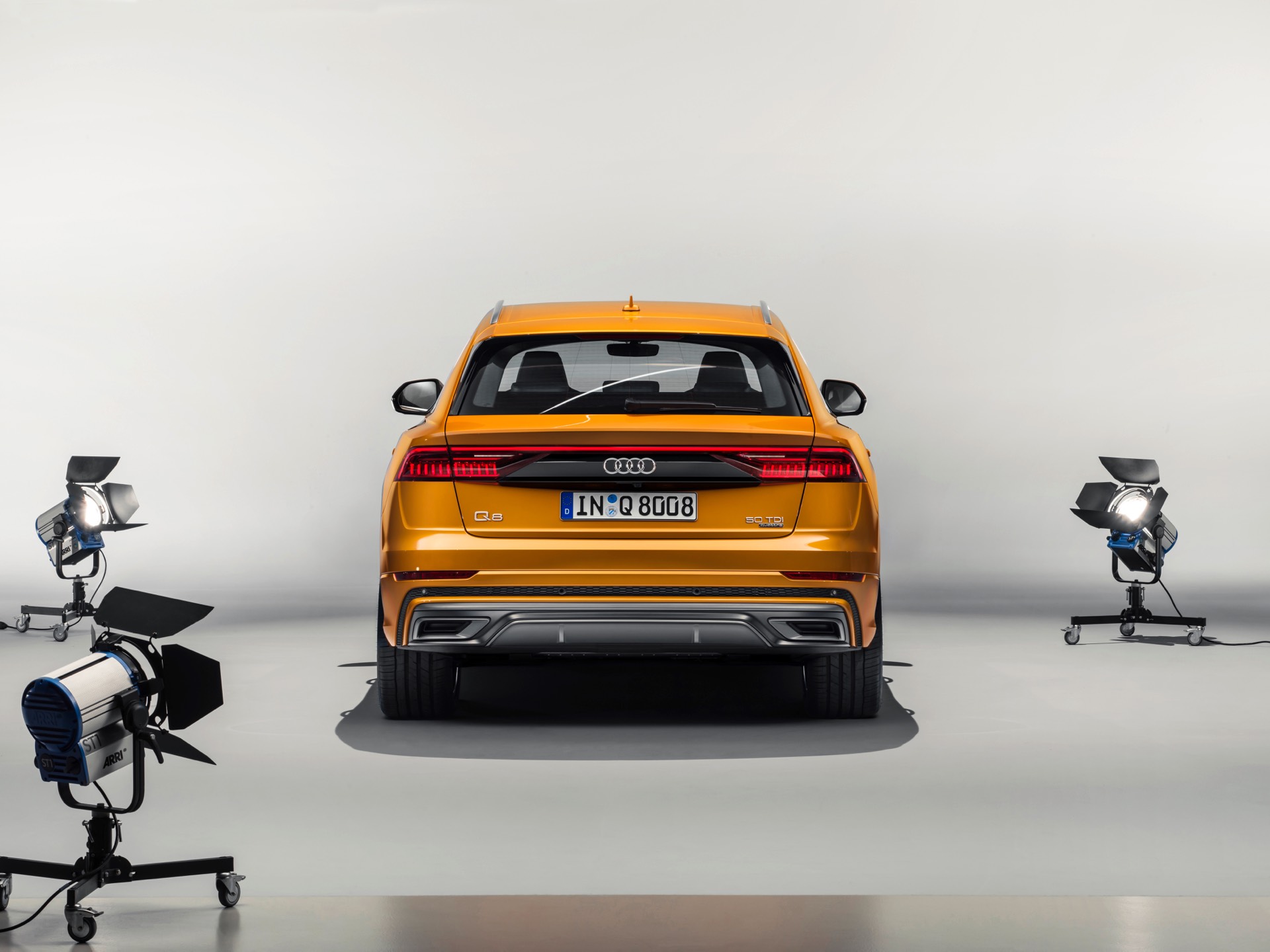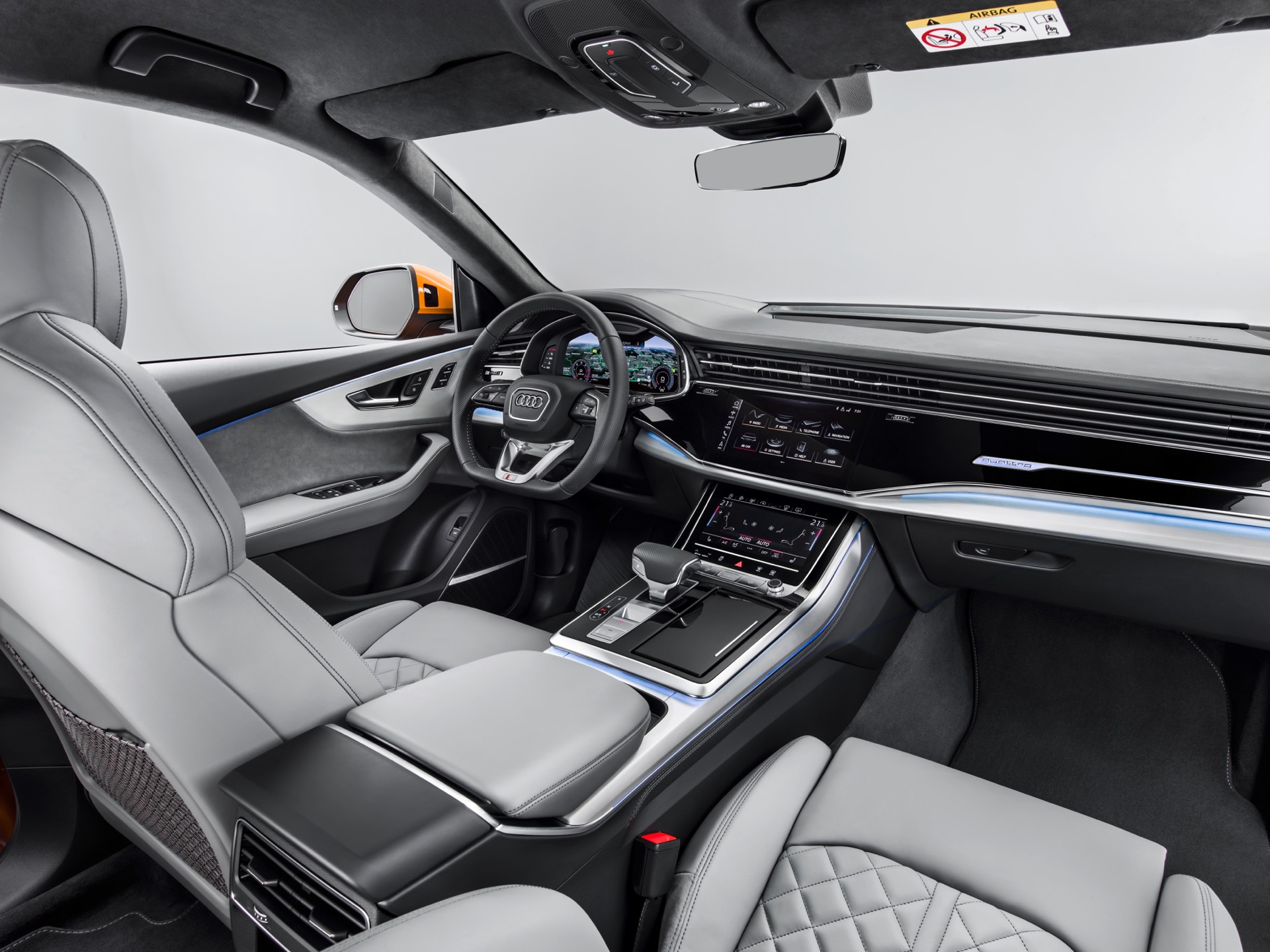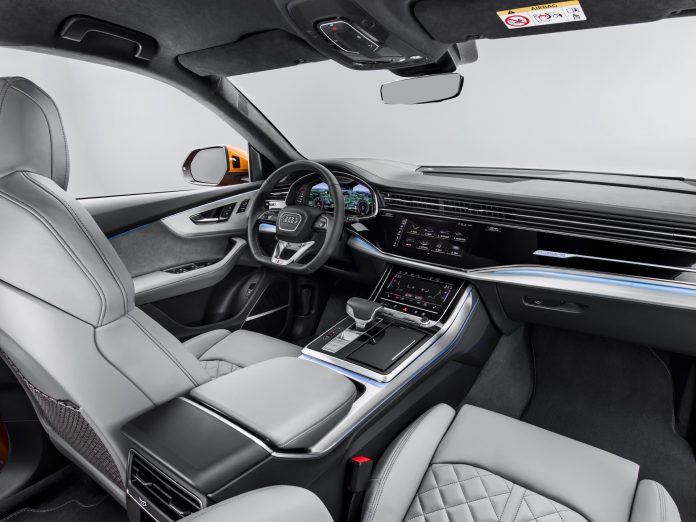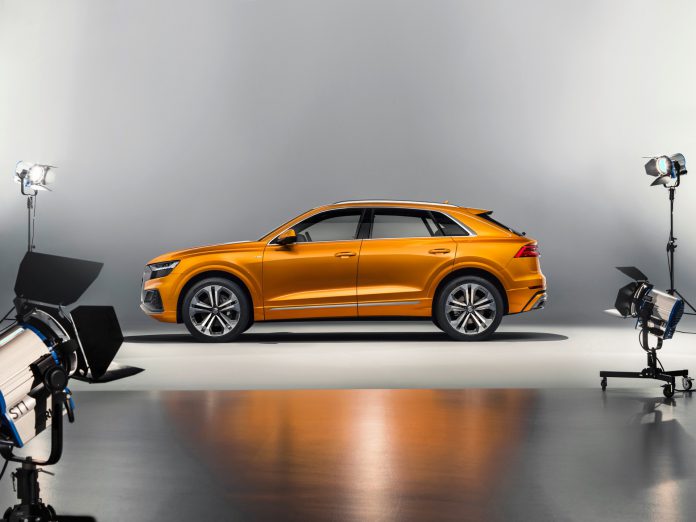The brand new Audi Q8 has finally been unveiled this evening. The launch event for the Q8 took place in Shenzhen in China, the home of the biggest Chinese technology companies. If anything, thats an indication as to Audi’s target market!
There are no surprises when it comes to shape. The Audi Q8 gets design language carried over from the A8. Among the standout features are the frameless doors which allow a coupe style look and the long roof spoiler. At the front, the single frame grille gets and octagonal design with six vertical chrome fins. The side profile clearly displays the trademark quattro blisters while the rear gets the integrated light strip which is now standard Audi issue.
Two headlight technologies will be available on the Q8. Both are LED, with the optional HD matrix LED headlights offering 24 individual LEDs. With a cd value of 0.34, the designers seem to have done a pretty good job of creating an efficient design.
The bodywork makes use of the Audi Space Frame concept. It is a blend of aluminum and steel components. Steel accounts for 14.4 percent of the body-in-white, cast aluminum 15 percent, aluminum plates 23.7 percent. All in, the Audi Q8 weighs 2,145 kilograms (4,728.9 lb).
In terms of size, the Audi Q8 measures 4.986 metres in length, 1.995 millimeters in width and 1.705 metres in height. Compared to the Q7, it is 66 millimeters shorter and 27 millimeters wider. Compared to the competition, the Q8 is slightly longer than, for example, the GLE Coupe and around the same height. It sits slightly narrow by comparison.
The rear tailgate is electrically powered as standard with a foot gesture option available on request. 605 litres of space are on offer which increases to 1,755 litres with the rear backrests folded down. The space the Q8 offers is class leading.
Quattro is standard. It uses a mechanical centre differential to transfer 40 percent power to the front and 60 percent to the rear. When struggling for grip, the Q8 has the ability to transfer power to any axle to optimise traction.
From an engineering viewpoint, the five-link front and rear suspension systems are constructed largely of aluminum. Audi offer three suspension options. The standard is a version with damper control. Optionally, an adaptive air suspension can be chosen. It includes controlled damping across four modes with the Audi drive select dynamic handling system. The most expensive option incorporates the all-wheel steering system. All three systems feature a progressive steering rack. Audi drive select gives seven different driving profiles.
Like most in this segment, the Audi Q8 gets off-road credentials. Ground clearance, the the adaptive air suspension systems is 254 millimeters. On slopes in excess of 6 percent, Audi’s hill descent control is available with the MMI system displaying the tilt angle.
The Audi Q8 sits on 19 inch wheels with options up to 22 inches available from launch. Being the bling sits a set of six-piston brakes with fixed aluminum calipers.
From launch (which will take place exclusively in Europe for the time being), the Audi Q8 will have one option. The 3.0 TDI with mild hybrid system is familiar and has been a feature of the A7 and A6 models we drove recently. The systems uses a lithium-ion battery and a belt alternator starter. A battery underneath the luggage compartment floor stores 10 Ah of electricity allowing the Q8 to efficiently coast between 55 and 160 km/h (34.2 and 99.4 mph) with the engine switched off.
The first model is the Q8 50 TDI which uses a 3.0 litre TDI unit. It generates 286 hp and delivers 600 Nm of torque, enough for a 100 km/h sprint of 6.3 seconds and a top speed of 232 km/h (144.2 mph). A smaller 3.0 litre diesel Q8 45 TDI will follow with 230 hp and a 3.0 TFSI gasoline-engine Q8 55 TFSI with 335 hp next year. The later will form the basis of the Asian and US model ranges. All engines will get the eight-speed tiptronic gearbox.
One thing point to note is that Audi fit the Q8 with a double-layer windshield as standard with the option of acoustic glass at an extra cost. The A7 and A8 are supremely quiet machines, the Q8 is likely to share these qualities despite it’s obvious disadvantages.
Inside, three trim levels will be made available; Premium, Premium Plus and Prestige. Leather seating is standard across the range with leather seats in all three versions. The top version benefits from Valcona leather. An optional S line sport package adds S sport seats with integrated head restraints, rhombus pattern and S logo. Four seat versions are available in total. All versions also include open pore wood or alluvium inlays.
The Q8 gets the familiar split upper and lower MMI touch response display from the A8, A7 and A6. The upper display uses a 10.1 inch screen for controlling the infotainment and the navigation system. The lower 8.6 inch display allows the driver to manage the heating, ventilation and air conditioning as well as comfort functions and text input.
MMI is where Audi excels. The system incorporates features such as natural language voice control which uses locally stored information together with intelligent cloud-based information to understand most voice commands. MMI navigation plus comes as standard.
Key features include the new LTE Advanced standard. The navigation system includes intelligent destination suggestions based on previous journeys. It is supplemented by information calculated online by navigation provider HERE. HERE uses real-time data from the Car-to-X services to ‘swarm’ intelligence from the Audi fleet. The Audi virtual cockpit is also standard with a high-resolution 12.3 inch display. It gets two views – classic and navigation – with a third Audi virtual cockpit plus option offering a sport look soon after launch.
For the ultimate in technology, Audi offer the Audi Connect key which allows access to the car from an Android smartphone. This will allow you to lock and unlock the car and start the engine remotely as well as to change the position of the drivers seat, set the air conditioning and program navigation details.
Audi also makes available its range of assistance systems in four bundles. The Tour assist package includes adaptive cruise assist, efficiency assist, an active accelerator pedal and emergency assist. The City package bundles five systems including crossing assist, Audi pre sense 360, exit warning and lane change warning. The Park plus package (available after launch) includes manoeuvring assist, curb warning, (remote) parking pilot and remote garage pilot. The final package is dedicated to towing.
Audi will build the Q8 at its Bratislava plant with the first cars hitting the European markets in July 2018. Twelve colours will be available including dragon orange and galaxy blue, two of its latest colours.

